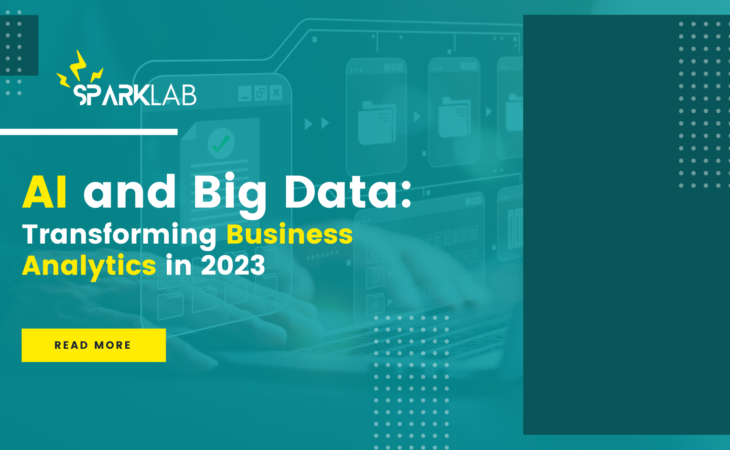
The role of AI in business analytics is significantly broader than one might expect. Businesses in the fast-paced digital environment are continuously looking for methods to acquire a competitive advantage and make informed decisions that drive success. With the increased availability of data, the function of business analytics has grown in importance.
Additionally, the convergence of AI and big data has revolutionized the field of business analytics in recent years. This has allowed firms to extract important insights and make data-driven choices like never before.
This article will investigate the transformational power of AI in business analytics, showcasing the most recent trends and advances in 2023.

Business analytics is the activity of analyzing company information using data and statistical methodologies to extract insights and help decision-making.
It entails the investigation, interpretation, and visualization of data in order to discover patterns, trends, and correlations.
Businesses can acquire a better knowledge of their operations, consumers, and market dynamics by applying analytical approaches to massive amounts of data.
In contrast, artificial intelligence (AI) is the replication of human intelligence in computers that are programmed to think and learn.
AI systems can process and analyze massive amounts of data rapidly and correctly, allowing organizations to derive useful insights and make more accurate forecasts.
More so, AI can learn from data, recognize trends, and create data-driven suggestions, removing the need for manual analysis and minimizing the margin of error.
The incorporation of AI in business analytics has resulted in a number of major benefits. For starters, AI improves the quality and dependability of data-driven insights.
AI systems can uncover complicated patterns and abnormalities in data using advanced algorithms, resulting in more accurate predictions and suggestions.
Second, artificial intelligence (AI) helps businesses to forecast future patterns and outcomes based on historical data, allowing them to make proactive decisions and avoid potential risks.
Finally, AI automates repetitive processes, freeing up time for data analysts to focus on more strategic and value-added activities.

The volume, velocity, and variety of data generated by organizations have increased exponentially in recent years.
This onslaught of data, colloquially known as big data, includes structured and unstructured data from a variety of sources. That includes customer transactions, social media interactions, sensor data, and more. Big data can fuel innovation, optimize operations, and improve decision-making by providing a wealth of insights.
However, organizations face enormous hurdles in realizing the potential of big data. The sheer volume of data makes standard data management and processing impossible.
Furthermore, the multiplicity of data types and sources complicates the process of properly integrating and evaluating information.
In addition, the rate at which data is generated necessitates the use of real-time processing capabilities in order to extract timely insights.
Businesses are looking for AI-powered analytics solutions to help them overcome these difficulties. AI algorithms can efficiently handle massive amounts of data, allowing firms to process, analyze, and generate insights from big data in a timely manner.
Moreover, artificial intelligence can automatically spot patterns and connections in heterogeneous datasets, revealing previously undiscovered insights.
Businesses can use AI to gain a competitive advantage and promote innovation in their respective industries by leveraging big data.

In 2023, the ecosystem of AI-powered business analytics solutions is fast evolving, providing enterprises with a diverse set of tools and methodologies for extracting value from their data.
Here are some significant AI-powered business analytics approaches:
A subset of AI, machine learning techniques, allows computers to learn from data and improve their performance without being explicitly programmed.
These algorithms are capable of analyzing large datasets, detecting patterns, and making predictions or suggestions.
Businesses can us Machine Learning to do activities such as consumer segmentation, demand forecasting, fraud detection, and tailored marketing.
Computers can read, interpret, and generate human language thanks to NLP.
NLP approaches are used in business analytics to evaluate text data, extract sentiment, and glean insights from consumer feedback, social media posts, and online reviews.
In addition, NLP applications in business analytics include sentiment analysis, topic modeling, and text categorization, which enable firms to acquire useful insights from unstructured text data.
Businesses are increasingly employing AI to scan images and videos for valuable insights as multimedia information proliferates.
Image recognition algorithms enabled by AI can detect objects, recognize faces, and categorize visual content, enabling applications like visual search, content moderation, and brand monitoring.
Furthermore, video analysis techniques can be employed for tasks such as behavior tracking, object detection, and video summarization, resulting in significant insights for industries such as retail, security, and entertainment.
Data visualization is an important part of data analysis because it allows firms to effectively communicate insights and make educated decisions. Creating aesthetically appealing and accurate charts and diagrams has traditionally taken a great amount of time and expertise. Businesses may now automate and streamline this process, saving time and enhancing the accuracy of visual representations, thanks to the emergence of AI-powered data visualization tools.
SparkLab’s Dynamic Dashboard is a unique data visualization application that employs the above phenomenon. This new technology uses the power of artificial intelligence, notably ChatGPT, to transform the way firms generate visualizations. The application generates spectacular charts and diagrams from a single-line prompt, precisely representing your data in an easily accessible format.
To produce personalized recommendations, recommendation systems use AI algorithms to assess user behavior, preferences, and historical data. These systems are commonly utilized in e-commerce, streaming services, and content platforms to deliver personalized products, movies, and content recommendations. Businesses can improve customer experience, increase sales, and increase user engagement by adopting AI-driven recommendation systems.
Moreover, SparkLab’s Customer Churn Predictor is a good example of such a system. Customer Churn Predictor assists firms in monitoring client retention and forecasting customer churn. The platform employs predictive analytics to identify consumers who are likely to leave, enabling organizations to take proactive steps to better engage and retain customers.

The incorporation of AI in business analytics has already proven to have a revolutionary influence across multiple industries. Let’s talk about some real-world examples and case studies:
Many online retailers use AI-powered analytics to optimize marketing campaigns, personalize customer experiences, and improve supply chain management.
Companies such as Amazon, for example, use AI algorithms to deliver personalized product recommendations based on their customers’ browsing and purchasing history. This promotes not only customer satisfaction but also sales and customer loyalty.
AI-driven analytics has the potential to transform healthcare by providing early disease identification, individualized treatment regimens, and predictive analytics for patient outcomes.
AI systems, for example, may scan medical pictures like X-rays and MRIs to find anomalies and assist radiologists in making correct diagnoses.
Furthermore, AI-powered predictive analytics can assist hospitals in forecasting patient admission rates and allocating resources more effectively.
AI-powered analytics is revolutionizing fraud detection, risk assessment, and investing strategies in the financial sector.
Financial institutions are using AI algorithms to evaluate massive amounts of transactional data in real-time, detecting anomalies and fraudulent activity.
Furthermore, predictive analytics powered by AI is utilized to assess credit risk and make data-driven investment decisions.
AI analytics is enhancing manufacturing processes by forecasting maintenance requirements, optimizing production schedules, and boosting quality control.
Plus, AI systems can spot patterns suggestive of possible problems by analyzing sensor data from machines, enabling proactive maintenance and decreasing costly downtime.
Furthermore, artificial intelligence-powered analytics can optimize production plans based on demand estimates, inventory levels, and resource availability.
In 2023, the integration of AI in business analytics will change the field of business analytics. Businesses can obtain a competitive advantage in their respective industries by employing AI-powered technologies to gain useful insights, make data-driven decisions, and establish a competitive advantage.
Nevertheless, to ensure the ethical and responsible use of AI in business analytics, firms have to address challenges relating to data quality, privacy, bias, and transparency. Adopting AI in business analytics offers up fresh possibilities for innovation, growth, and better decision-making, paving the way for a brighter future for organizations in the data-driven era.